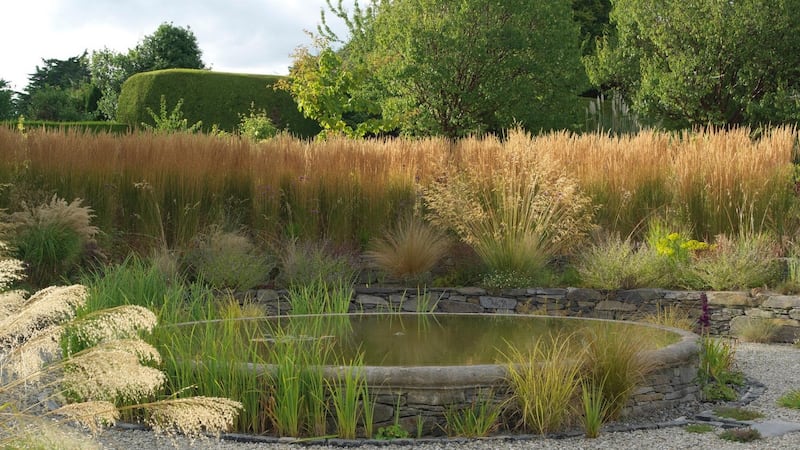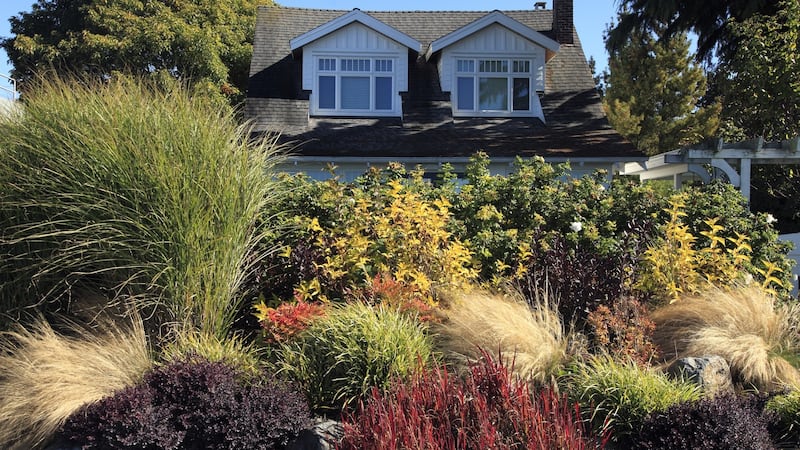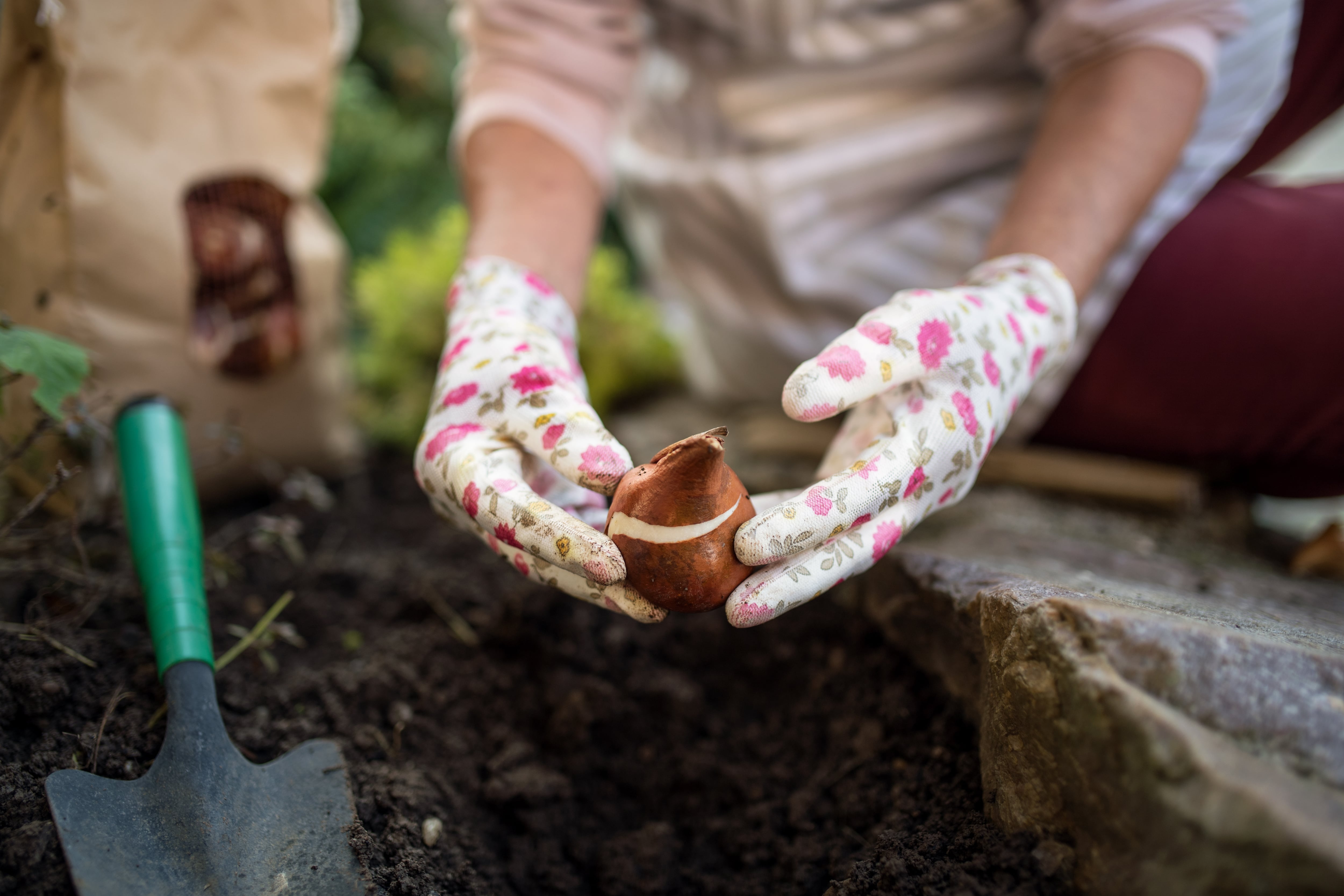Ornamental grasses with outstanding autumn interest particularly suitable for smaller spaces include the aristocratic Hakonechloa macra, a shade-loving, herbaceous perennial species that partners brilliantly with ferns, hostas, hellebores and irises. Its soft plumes of billowing foliage slowly flush to shades of red and crimson as autumn approaches. Another – and one that provides year-round-interest – is the evergreen, perennial, clump-forming Carex morrowii ‘Irish Green’, which is also happiest in shade. A third, if you can give it a semiwild spot and a free-draining soil in full sun where its tendency to abundantly self-seed will be a bonus rather than a problem, is Briza maxima. This hardy annual species has the daintiest of quivering pale purple-green flower panicles that slowly fade to silver-gold as autumn arrives.
The latter is something not always immediately associated with this group of plants. But in fact the long-lasting flowers of many kinds of ornamental grasses are one of their great charms, effortlessly adding a softly luminous glow to a planting scheme and pairing brilliantly with other late-flowering perennials such as aster, sanguisorba, persicaria, helenium, agapanthus, rudbeckia, dahlia and helianthus.
In my own garden, the whiskery, silver-grey flower spikes of Pennisetum villosum, a species commonly known as feathertop, are one of its particular autumnal joys, each fluffy, feathery inflorescence trembling in the slightest breeze and gently illuminated by the near-horizontal rays of the September sun. A relatively compact, herbaceous species, I grow it in a warm, sunny, sheltered spot by our front door next to the handsome evergreen spurge, Euphorbia wulfenii, and orange Californian poppies, an eye-pleasing combination that offers long-lasting interest in terms of contrasting silhouettes and growth habits.
[ Autumn comes bearing gifts for the gardenOpens in new window ]
Easily raised from seed, like all pennisetums it needs plenty of heat, full sun, and a lightish, moist but very free-draining soil in a sheltered spot to flourish. If your garden’s soil is heavy and inclined to winter wet, then add plenty of horticultural grit or choose a spot next to a path or wall where the drainage is naturally sharper. Alternatively, a sunny gravel garden is also a great spot, providing exactly the kind of soil conditions needed. Other garden-worthy varieties of pennisetum include the glorious, silver-pink Pennisetum ‘Karley Rose’; Pennisetum ‘Fairy Tails’; the hardy, stately Pennisetum orientale ‘Shogun’; and the Chinese fountain grass, Pennisetum alopecuroides ‘Hameln’, all of which have fluffy, bottlebrush-like flowers in shades of silvery-creamy-dusty-plaster-pink.
READ MORE

All of the above also offer plenty of pretty autumnal colour, as their foliage fades to gold before dying back to the ground in late autumn. If you have a glasshouse, polytunnel or conservatory in which to overwinter it under cover, plus the patience to do so, then the frost-tender hybrid Pennisetum x advena ‘Rubrum’ also makes a magnificent container plant for the early autumn garden.
No such kind of mollycoddling is required for Stipa gigantea, a hardy, stately golden oats grass that forms large, dense tussocks of fine, evergreen foliage, above which its very tall and graceful panicles of oat-like flowers appear in summer. These persist for many months on the plant, slowly flushing rose-gold as the seasons progress. It is utterly spectacular in a sunny border or gravel garden grown amid a lower canopy of plants where the shimmering flower stems will catch any gleams of sunlight; it has a majesty that has ensured its enduring popularity. It is tolerant of a wide range of soils so long as they’re not sodden. In my own sunny front garden, I grow it among semi-transparent clouds of linaria, calaminth, gaura, sanguisorba and perennial geraniums. Despite its considerable height and spread (2m-plus by 1.2m, and taller again for the magnificent variety known as Stipa ‘Golden Fontaene’), its airy growth habit means that it can also be grown successfully in smaller gardens.
The miscanthus genus is hardy and statuesque but not evergreen. It is home to an equally outstanding range of herbaceous species of ornamental grasses that add texture, colour and all-important glimmer to the autumn garden. These imposing, clump-forming plants are not suitable for smaller spaces or for very windy, exposed gardens, where they can look untidy. They can quickly reach a height and spread of 1.8m by 1.4m or more, depending on the variety. Classics include Miscanthus sinensis ‘Maelpartus’, whose tall, feather, dusty-red flower plumes emerge in late summer before slowly fading to silver -pink. Its handsome leaves are another boon, each marked with a central mid-rib of silver, as is its autumn foliage colour. Other outstanding varieties to seek out include Miscanthus nepalensis (exceptionally long-lasting, tall, elegant flower plumes) and Miscanthus sinensis ‘Graziella’ (silver-pink long-lasting flowers and colourful autumn foliage).

Calamagrostis brachytricha is yet another achingly beautiful, hardy, versatile ornamental grass prized for its tall, gauzy, long-lasting flower plumes as well as its colourful autumn foliage. It is happy in full sun or light shade. Its flowers emerge in summer but persist on the plants well into autumn. Other classic varieties include Calamagrostis ‘Overdam’ and the similar C ‘Karl Foerster’, both of which have a very architectural, vertical growth habit and do best in a sunny, well-drained spot.
Ornamental grasses with outstanding autumn interest particularly suitable for smaller spaces include the aristocratic Hakonechloa macra, a shade-loving, herbaceous perennial species that partners brilliantly with ferns, hostas, hellebores and irises. Its soft plumes of billowing foliage slowly flush to shades of red and crimson as autumn approaches. Another – and one that provides year-round-interest – is the evergreen, perennial, clump-forming Carex morrowii ‘Irish Green’, which is also happiest in shade. A third, if you can give it a semiwild spot and a free-draining soil in full sun, where its tendency to abundantly self-seed will be a bonus rather than a problem, is Briza maxima. This hardy annual species has the daintiest of quivering pale purple-green flower panicles that slowly fade to silver-gold as autumn arrives.
Yet another stalwart is the pheasant tail grass or Anemanthele lessoniana (formerly known as Stipa arundinaceae), a hardy, vigorous, versatile, semi-evergreen species that will happily tolerate less-than-ideal growing conditions and looks best planted en masse. Along with its dainty panicles of flowers, which appear in late summer, its colourful autumnal foliage is one of the glories of this decorative species as its slender leaves turn to shades of gold, copper and scarlet. The pheasant tail grass will grow quite happily in dampish soil and in both full sun and light shade, as will the moor grass, Molinia caerulea ssp caerulea ‘Heidebraut’, another supremely decorative herbaceous grassy species with tall, quivering, violet flower spikes that gently fade to gold in autumn.
While their preferred growing conditions vary greatly, what almost all of the above ornamental grasses deeply dislike is to be newly planted or divided in autumn. Instead make sure to wait until spring, when they will establish quickly, soon rewarding you with their graceful, gauzy, good looks.
This week in the garden
- With the first of autumn’s killing frosts on the horizon, make sure to label dahlia varieties while they’re still in flower so that they are easily identifiable. This is especially important if you’re planning on lifting the tubers and overwintering them indoors.
- Start hand-pick ripening apples, bearing in mind that only certain varieties are suitable for storing longer than a few weeks (these are typically late-season varieties) and that any with obvious bruises or nicks in the skins are going to be very prone to decay. Earlier ripening varieties can be stored for up to four to eight weeks while later varieties will ripen in storage and can be stored for several months in a cool, dark, rodent-proof, frost-free spot such as a disused chest freezer.
Dates for your diary
Friday-Sunday, October 4th-6th, Kells Bay Gardens Southern Symposium IX, with an impressive line-up of guest speakers that includes Adam Frost, Scott McMahan, Jimi Blake, Derry Watkins and Raf Lenaerts, booking essential. kellsbay.ie
















